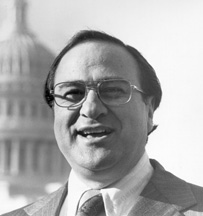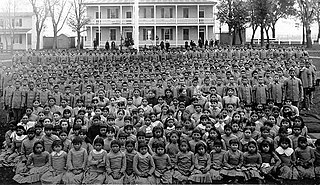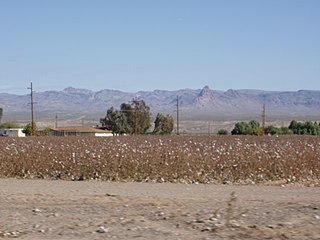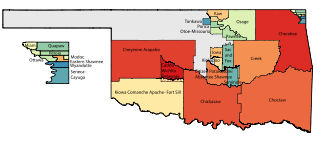
Tribal sovereignty in the United States is the concept of the inherent authority of indigenous tribes to govern themselves within the borders of the United States.

James George Abourezk is an American attorney and Democratic politician who served as a United States senator and United States representative from South Dakota. He did not seek re-election to the US Senate in 1978. He was the first Greek Orthodox Christian of Lebanese-Antiochite descent to serve in the US Senate. He was generally viewed as critical of US foreign policy in the Middle-East and North Africa (MENA) area, particularly regarding Palestine and Israel.

The Choctaw Nation is a Native American territory covering about 6,952,960 acres, occupying portions of southeastern Oklahoma in the United States. The Choctaw Nation is the third-largest federally recognized tribe in the United States and the second-largest Indian reservation in area after the Navajo. As of 2011, the tribe has 223,279 enrolled members, of whom 84,670 live within the state of Oklahoma and 41,616 live within the Choctaw Nation's jurisdiction. A total of 233,126 people live within these boundaries, with its tribal jurisdictional area comprising 10.5 counties in the state, with the seat of government being located in Durant, Oklahoma. It shares borders with the reservations of the Chickasaw, Muscogee, and Cherokee, as well as the U.S. states of Texas and Arkansas. By area, the Choctaw Nation is larger than eight U.S. states.
In law, a ward is a minor or incapacitated adult placed under the protection of a legal guardian or government entity, such as a court. Such a person may be referenced as a "ward of the court".
The Mississippi Band of Choctaw Indians is one of three federally recognized tribes of Choctaw Native Americans, and the only one in the state of Mississippi. On April 20, 1945, this tribe organized under the Indian Reorganization Act of 1934. Their reservation in included lands in Neshoba, Leake, Newton, Scott, Jones, Attala, Kemper, and Winston counties. The Mississippi Choctaw regained stewardship of their mother mound, Nanih Waiya mounds and cave in 2008. The Mississippi Band of Choctaw have declared August 18 as a tribal holiday to celebrate their regaining control of the sacred site. The other two Choctaw groups are the Choctaw Nation of Oklahoma, the third largest tribe in the United States, and the Jena Band of Choctaw Indians, located in Louisiana.

The Indian Child Welfare Act of 1978 (ICWA) is a United States federal law that governs jurisdiction over the removal of American Indian children from their families in custody, foster care and adoption cases.

American Indian boarding schools, also known more recently as American Indian residential schools, were established in the United States from the mid-17th to the early 20th centuries with a primary objective of "civilizing" or assimilating Native American children and youth into European American culture. In the process, these schools denigrated Native American culture and made children give up their languages and religion. At the same time the schools provided a basic Western education. These boarding schools were first established by Christian missionaries of various denominations. The missionaries were often approved by the federal government to start both missions and schools on reservations, especially in the lightly populated areas of the West. In the late 19th and early 20th centuries especially, the government paid religious orders to provide basic education to Native American children on reservations, and later established its own schools on reservations. The Bureau of Indian Affairs (BIA) also founded additional off-reservation boarding schools based on the assimilation model. These sometimes drew children from a variety of tribes. In addition, religious orders established off-reservation schools.
The Harvard Project on American Indian Economic Development, also known as the Harvard Project, was founded in 1987 at Harvard Kennedy School at Harvard University. It administers tribal awards programs as well as provides support for students and conducting research. The Harvard Project aims to understand and foster the conditions under which sustained, self-determined social and economic development is achieved among American Indian nations through applied research and service.
The Association on American Indian Affairs is a nonprofit human rights charity located in Rockville, Maryland. Founded in 1922, it is dedicated to protecting the rights of Native Americans.

Indian country jurisdiction, or the extent which tribal powers apply to legal situations in the United States, has undergone many drastic shifts since the beginning of European settlement in America. Over time, federal statutes and Supreme Court rulings have designated more or less power to tribal governments, depending on federal policy toward Indians. Numerous Supreme Court decisions have created important precedents in Indian country jurisdiction, such as Worcester v. Georgia, Oliphant v. Suquamish Tribe, Montana v. United States, and McGirt v. Oklahoma.
Montana v. United States, 450 U.S. 544 (1981), was a Supreme Court case that addressed two issues: (1) Whether the title of the Big Horn Riverbed rested with the United States, in trust for the Crow Nation or passed to the State of Montana upon becoming a state and (2) Whether Crow Nation retained the power to regulate hunting and fishing on tribal lands owned in fee-simple by a non-tribal member. First, the Court held that Montana held title to the Big Horn Riverbed because the Equal Footing Doctrine required the United States to pass title to the newly incorporated State. Second, the Court held that Crow Nation lacked the power to regulate nonmember hunting and fishing on fee-simple land owned by nonmembers, but within the bounds of its reservation. More broadly, the Court held that Tribes could not exercise regulatory authority over nonmembers on fee-simple land within the reservation unless (1) the nonmember entered a "consensual relationship" with the Tribe or its members or (2) the nonmember's "conduct threatens or has some direct effect on the political integrity, the economic security, or the health or welfare of the tribe."
Santa Clara Pueblo v. Martinez, 436 U.S. 49 (1978), was a landmark case in the area of federal Indian law involving issues of great importance to the meaning of tribal sovereignty in the contemporary United States. The Supreme Court sustained a law passed by the governing body of the Santa Clara Pueblo that explicitly discriminated on the basis of sex. In so doing, the Court advanced a theory of tribal sovereignty that weighed the interests of tribes sufficient to justify a law that, had it been passed by a state legislature or Congress, would have almost certainly been struck down as a violation of equal protection.
The Supreme Court decision in Obergefell v. Hodges that legalized same-sex marriage in the states and most territories did not legalize same-sex marriage on Indian reservations. In the United States, Congress has legal authority over tribal reservations. Thus, unless Congress passes a law regarding same-sex marriage that is applicable to tribal governments, federally recognized American Indian tribes have the legal right to form their own marriage laws. As such, the individual laws of the various United States federally recognized Native American tribes may set limits on same-sex marriage under their jurisdictions. At least ten reservations specifically prohibit same-sex marriage and do not recognize same-sex marriages performed in other jurisdictions; these reservations, alongside American Samoa, remain the only parts of the United States to enforce explicit bans on same-sex couples marrying.
The following outline is provided as an overview of and topical guide to United States federal Indian law and policy:

Oklahoma Tribal Statistical Area is a statistical entity identified and delineated by federally recognized American Indian tribes in Oklahoma as part of the U.S. Census Bureau's 2010 Census and ongoing American Community Survey. Many of these areas are also designated Tribal Jurisdictional Areas, areas within which tribes will provide government services and assert other forms of government authority. They differ from standard reservations, such as the Osage Nation of Oklahoma, in that allotment was broken up and as a consequence their residents are a mix of native and non-native people, with only tribal members subject to the tribal government. At least five of these areas, those of the so-called five civilized tribes of Cherokee, Choctaw, Chickasaw, Creek and Seminole, which cover 43% of the area of the state, are recognized as reservations by federal treaty, and thus not subject to state law or jurisdiction for tribal members.
United States v. John, 437 U.S. 634 (1978), was a case in which the Supreme Court of the United States held that lands designated as a reservation in Mississippi are "Indian country" as defined by statute, although the reservation was established nearly a century after Indian removal and related treaties. The court ruled that, under the Major Crimes Act, the State has no jurisdiction to try a Native American for crimes covered by that act that occurred on reservation land.
Adoptive Couple v. Baby Girl, 570 U.S. 637 (2013), was a decision of the Supreme Court of the United States that held that several sections of the Indian Child Welfare Act (ICWA) do not apply to Native American biological fathers who are not custodians of a Native American child. The court held that the procedures required by the ICWA to end parental rights do not apply when the child has never lived with the father. Additionally, the requirement to make extra efforts to preserve the Native American family also does not apply, nor is the preferred placement of the child in another Native American family required when no other party has formally sought to adopt the child.
Dollar General Corp. v. Mississippi Band of Choctaw Indians, 579 U.S. ___ (2016), was a United States Supreme Court case in which the Court was asked to determine if an American Indian tribal court had the jurisdiction to hear a civil case involving a non-Indian who operated a Dollar General store on tribal land under a consensual relationship with the tribe. The Court was equally divided, 4–4, and thereby affirmed the decision of the lower court, in this case the United States Court of Appeals for the Fifth Circuit, that the court had jurisdiction.
The Maine Wabanaki-State Child Welfare Truth and Reconciliation Commission, also known as the MWTRC was a commission looking at events relating to Wabanaki children and families from 1978, when the Indian Child Welfare Act (ICWA) was passed, until now. The Commission was officially established on February 12, 2012 and issued its final report on June 14, 2015. The MWTRC's mandate was to find Truth, Healing and Change by giving the Wabanaki people and others involved within the Maine Child Welfare System a place to voice their stories and experiences. The final report addressed findings made by the commission and provided recommendations to improve compliance with the ICWA.
Haaland v. Brackeen is a pending Supreme Court of the United States case brought by the states of Texas, Louisiana, and Indiana, and individual plaintiffs, that seeks to declare the Indian Child Welfare Act (ICWA) unconstitutional. In addition to Haaland v. Brackeen, three additional cases have been consolidated to be heard at the same time. Those cases are Cherokee Nation v. Brackeen, Texas v. Haaland, and Brackeen v. Haaland.







